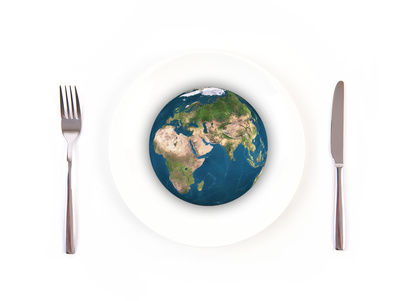Share This
When it comes to tackling issues of climate change, chronic disease, and rising health care costs, the solutions rarely seem simple. So naturally it caught our attention when a new study came out in January suggesting that all these challenges might be mitigated by changing one thing: our diet.
Roughly one third of global greenhouse gas emissions originate from our food system – the system that produces, manufactures and distributes the food that we eat. As global efforts to reduce emissions gain traction, understanding the links between our diet, our health and our climate is becoming increasingly important.
The prevalence of diet-related diseases, like diabetes, cancer and heart disease, contributes to the rising costs of healthcare in the US. In 2014, the US spent $3 trillion on healthcare, almost one fifth of the total US GDP. And the healthcare system, itself, contributes to greenhouse house emissions – 69-84 kg of carbon dioxide per person per year, the recent study found. Given all these connections, perhaps it is unsurprising to discover how profoundly impactful a shift toward healthier, more sustainable diets could be.
Researchers in the climate and diet study tested several alternatives diets but they were all based around the same health and sustainability principles:
- Increase consumption of whole grains
- Increase fruit and vegetable consumption
- Increase consumption of beans and peas
- Decrease red meat and processed meat consumption
- Decrease consumption of refined grains
A 2012 study found that it takes just ⅛ gallon (about two cups) of water to produce one calorie of whole grain, and only ⅓ gallon of water to cultivate 1 calorie of pulses (beans and peas) or grow 1 calorie of vegetables. In contrast, a calorie of beef requires 2.7 gallons of water, making it the most resource-intense food in our diet. It takes 10% more grain to made one pound of white rice than it does to make one pound of brown rice, and one bushel of wheat can be made into 60 loaves of whole wheat bread, but only yields 42 loaves of white bread. Brown rice, whole wheat, and other whole grain varieties are very clearly the better option both environmentally and nutritionally.
The 2017 climate and diet study found that the carbon emissions reduction that would result from adopting these healthier diets, would be equivalent to every person driving 500-2000 fewer miles each year. The emissions reduction from this diet change alone would allow the US to meet between 6-24% of the US Climate Action Plan’s targets.
Of course, shifting an entire population’s eating patterns is no easy feat. The good news is that we all make choices about the food we eat every single day, and we have the power to effect change with every meal we make! Choosing whole grains over refined grains is often a very easy (and super tasty) switch that’s good for your body and good for your planet.
If you’re interested in learning more about whole grains and sustainability, check out our fun infographic and read more about this topic in our recent Oldways Table blogpost. (Caroline)


Add a Comment